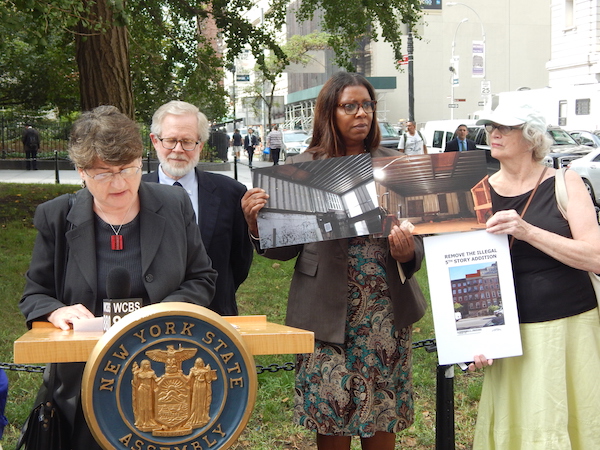
BY SEAN EGAN | Preservationists who’ve rallied for years around the Hopper-Gibbons House (339 W. 29th St., btw. Eighth & Ninth Aves.) — the only documented Underground Railroad site in Manhattan — were left frustrated after the Landmarks Preservation Commission (LPC), at its Tues., Sept. 20 hearing, decided not to take any action regarding the building. At this hearing, the LPC could have required the owner to remove a contentious fifth-floor addition from the row house and restore it to its previous four-story height — the ultimate goal of advocates.
Controversy has surrounded the house because its owner, Tony Mamounas, has been trying to legitimize a fifth-floor penthouse he began building when in possession of erroneously issued permits from the Department of Buildings.
The building was landmarked in 2009 as part of the Lamartine Historic District, just after those permits were revoked and Stop Work Orders were issued — though work on the addition continued, according to locals. Court decisions in 2013 and 2015 upheld that Mamounas must gain approval from the LPC before continuing construction.
In the 1800s, the house served as the home of abolitionist Abigail Hopper-Gibbons, and a safe haven for runaway slaves, making it a target during the racially charged Draft Riots of 1863. When the house was ransacked and set ablaze, the Hopper-Gibbons fled to safety by running across the row of houses’ flush rooflines — the historical importance of which making Mamounas’ fifth floor addition a particularly offensive to preservationists.
Prior to the site’s hearing, the Friends of the Hopper-Gibbons House Underground Railroad Site staged a press conference across from the LPC’s headquarters (1 Centre St.), to implore them to call for the restoration of the house. Joining the Friends’ Co-Presidents Julie Finch and Fern Luskin were State Assemblymember Richard Gottfried and Public Advocate Letitia James — though more than two dozen elected officials co-signed a statement calling for the rejection of the owner’s application to the LPC.
“It’s important to protect [the Hopper-Gibbons House] from being defaced by its owner,” Gottfried said in his opening remarks.
“We have a responsibility to maintain and preserve these kinds of landmarks,” James concurred. “Most importantly, we’re here today to protect American history.”
“This building is special, sacred, and unique in Manhattan,” added Luskin, noting that if Mamounas wasn’t penalized and made to remove the addition, “other developers will feel gleefully unencumbered by the law.”
Shortly thereafter, at the packed-house hearing, Marvin Mitzner, the owner’s lawyer and applicant, presented plans that would include a modified penthouse addition and bulkhead, to be slanted and set back 10 feet in an effort to make it unnoticeable from the street (a claim locals refute). They also touted the front façade restoration they would undertake, replacing the stucco exterior with brick.
In the public testimony period that followed, over a dozen advocates — from high school students to veteran attorneys — took to the mike to ask the LPC to save the house.
“This defacing is, and will be, plainly visible from public thoroughfare,” Gottfried testified, noting “the lion’s share of the work” on the “monstrosity on top of his landmark” was done illegally. “The owner should not be permitted to circumvent these rules,” he declared.
The LPC was then regaled (numerous times) with story of the Hopper-Gibbons’ flight across the rooftops, and pleas to restore the house. Patrick Waldo, of the preservationist group Save Chelsea, said the history of the house represents “a cautionary tale” important to preserve in this day an age, as figures like Donald Trump stoke racial tensions amongst the working class.
For their part, it was clear the LPC commissioners did not feel positively about the rooftop addition after hearing the testimony (and receiving 135 emails regarding the project).
“It seems to me that what makes the district unique from others is its roofline and cultural significance,” commented LPC Chair Meenakshi Srinivasan. “For me you can’t separate the two,” she said, noting that the fifth floor gave her “great pause” because “the cultural significance manifests itself in the physicality of the building.”
Another commissioner, Michael Devonshire, was more blunt in his appraisal, likening the addition to building a Holiday Inn on the site of the Battle of Gettysburg. Commission Michael Goldblum also criticized the historical accuracy of the “thin brick” they proposed to use for the façade restoration.
Nonetheless, the commissioners decided to not take any action regarding Mitzner’s application, as there was a lot of material for the commissioners to absorb and consider to prepare for a deeper discussion — though they advised Mitzner to re-examine the plans with their desire for the addition’s removal in mind. The house’s fate, then, is up in the air until the LPC takes a more concrete stance. Chelsea Now will continue to follow this saga until they do.

















